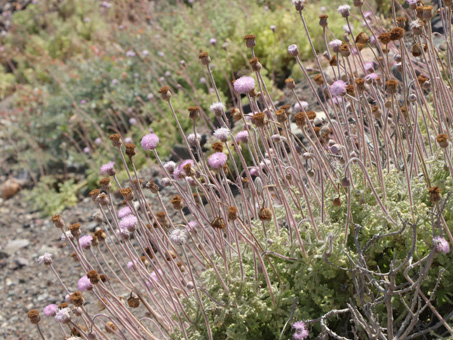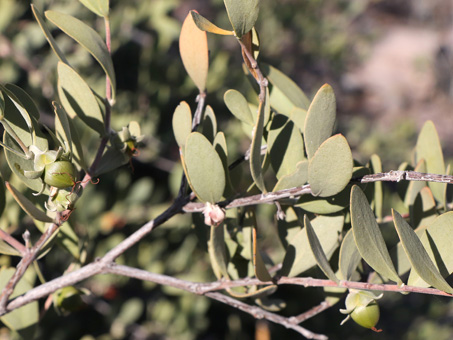This section contains entries about our botanizing in Baja California written for the UC BEE (Oct 2012 to Aug 2021)
and The UC Bee Hive (2022-), monthly newsletters for volunteers and staff of the UC Berkeley Botanical Garden.
Click on any photo for a larger image.
BEE JUN 2020
Punta Prieta, Mulegé (part 2) — May 3, 2020
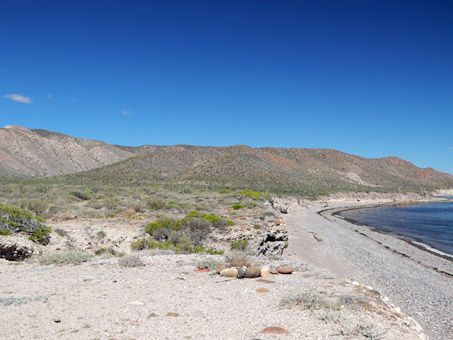 It's now been about 6 weeks since we have been sheltering-in-place per order of the Mexican goverment. The weather has turned abruptly, as it does this time of the year, and we have been going through an intermittent bake-steam cycle: hot and dry for a day or two followed by a day or two of hot and humid. Early in this (so far) two week cycle, one morning was absolutely refreshing when we woke to fog rolling in from the Gulf.
It's now been about 6 weeks since we have been sheltering-in-place per order of the Mexican goverment. The weather has turned abruptly, as it does this time of the year, and we have been going through an intermittent bake-steam cycle: hot and dry for a day or two followed by a day or two of hot and humid. Early in this (so far) two week cycle, one morning was absolutely refreshing when we woke to fog rolling in from the Gulf.
This month I wanted to share a few more images of the bluff mentioned in last month's entry. The week after our trail hike, we took a walk along the beach below the bluff for a better view of the underlying structure, and learned a lot more about its composition.
There are also images from more of the plants growing both along the trail above and at the base of the bluff from a walk we took today, May 3. What a difference a month makes in how the desert scrub looks and smells. It's amazing to witness the cycles of life, death and renewal taking place all at once.
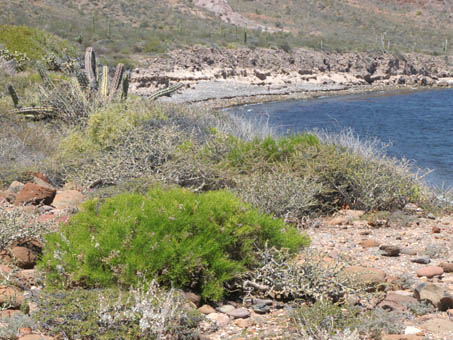 To recap, the specific area we visited today and last month is located on the Gulf of California on the north side of the Mulegé river. The narrow, mostly rocky (cobble, shingle) beach stretches from Punta Prieta northward to Punta Colorado. It faces Bahía de Santa Inés.
To recap, the specific area we visited today and last month is located on the Gulf of California on the north side of the Mulegé river. The narrow, mostly rocky (cobble, shingle) beach stretches from Punta Prieta northward to Punta Colorado. It faces Bahía de Santa Inés.
Common plants along the bluff include: Atriplex barclayana, Bajacalia crassifolia, Cylindropuntia cholla, Dalea mollis, Drymaria holosteoides var. holosteoides, Gundlachia diffusa, Maytenus phyllanthoides, & Perityle emoryi. Those near the base of the bluff & beach berm include: Atriplex barclayana, Bajacalia crassifolia, Hofmeisteria fasciculata var. fasciculata & Perityle emoryi. See below or last month's entry for the full plant list.
The Bluff — April 19, 2020
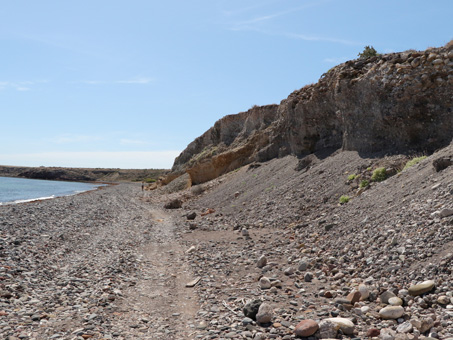
On the shingle beach below the bluff, about half way along and looking towards Punta Prieta. See the tiny person in the distance at the base of the 7-8 m H bluff? The scree on right, the cobbly berm on left.
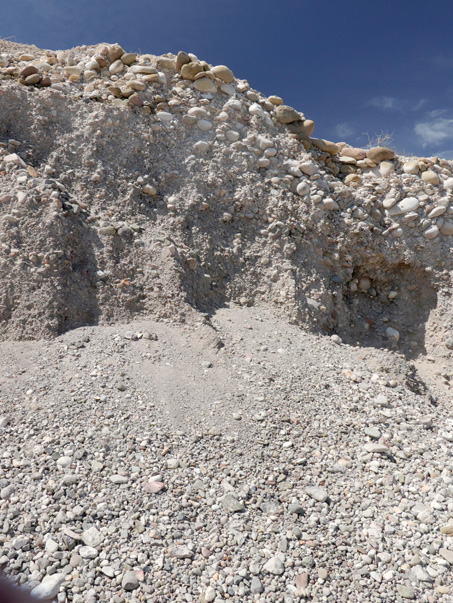
Pebbles and rocks from alluvial deposits eroding from the lower layers of the bluff.
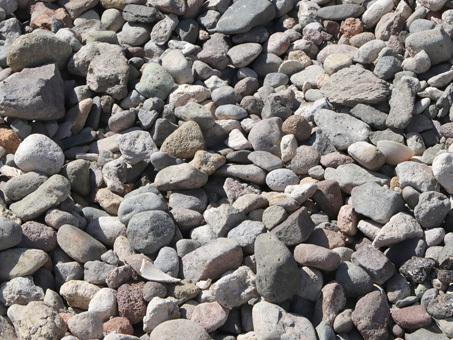
These mostly volcanic stones and some shell fragments from the scree just below the bluff are barely rounded and have sharper edges.
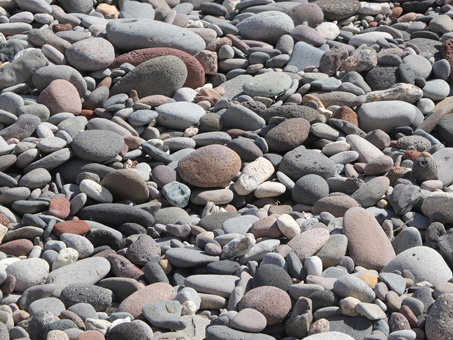
By comparison, the berm's stones & shells are smooth & rounded, having been tumbled by wave action for who-knows-how-long.
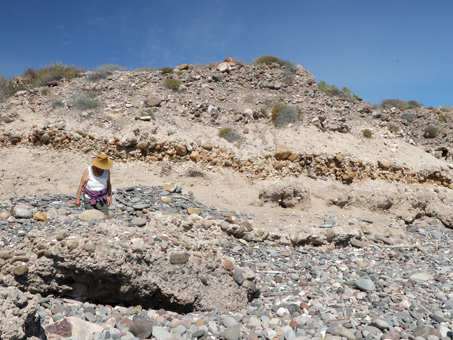
Alternating layers of rocky alluvial and marine deposits with a thin volcanic layer (lava and ash) at the top.
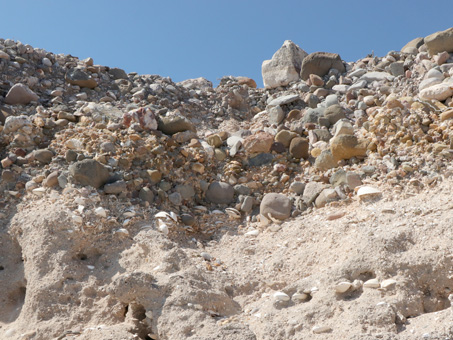
The lower, pale layer is a consolidated marine layer, embedded with shells and other invertebrates, including chunks of coral, but they don't appear to be fossilized.
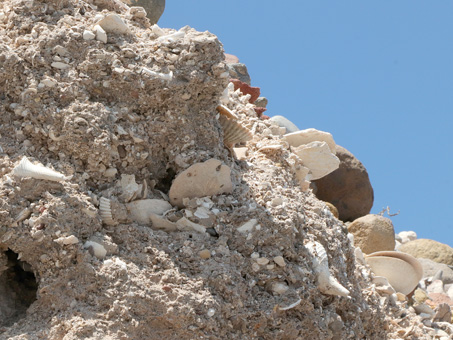
Above the consolidated layer is a layer of looser marine sediments and inclusions of clam, scallop and murex shells, sand dollars, corals and pebbles, among others.
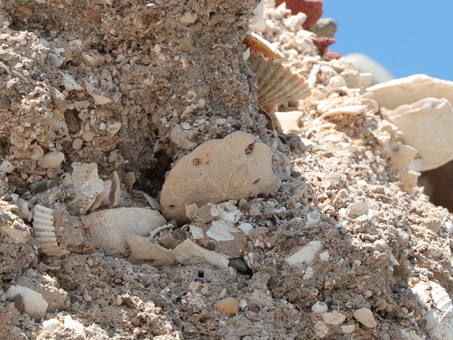
Closeup of the less-consolidated marine layer. That sand-dollar is solidly embedded, but the grain of the surrounding matrix is much more coarse than the layer below.
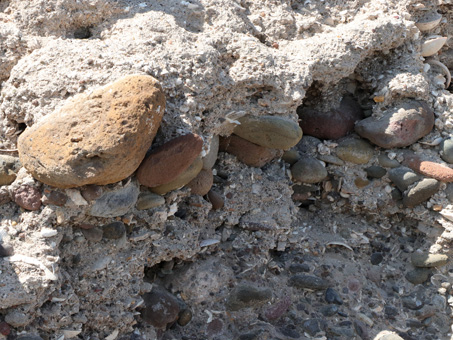
The lowest exposed layer here shows alluvial deposits of volcanic origin firmly embedded in the finer grained marine sediment.
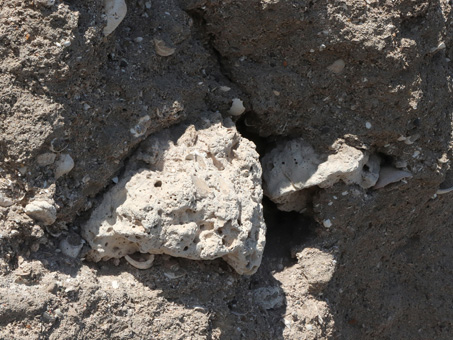
A chunk of coral, about 20 cm W x H embedded in the lower marine sediment layer and slowly being exposed by wind and wave action.
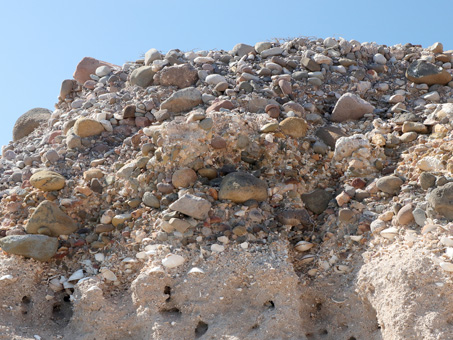
Upper layers of the bluff. The lower marine layer showing honeycombing: inclusions fall out and the holes enlarge from further erosion by wind and water.
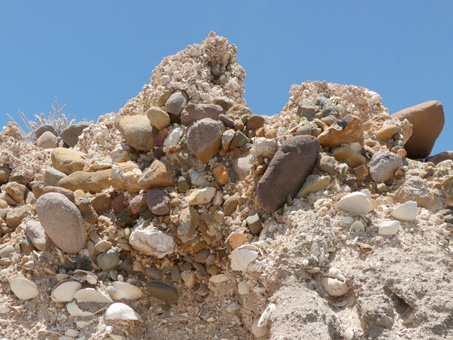
Upper, less consolidated layer of the bluff. Just a little marine "cement" is holding some of these inclusions in place.
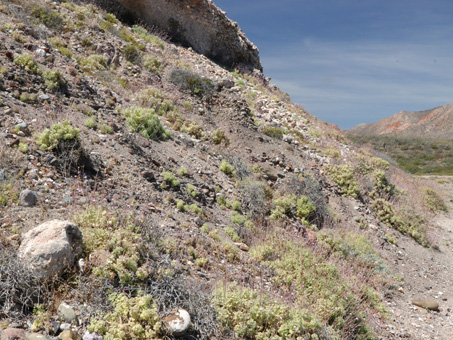
Bluff base closer to Punta Prieta, with Coast Hofmeistera (Hofmeisteria fasciculata var. fasciculata, Asteraceae) the dominant plant.
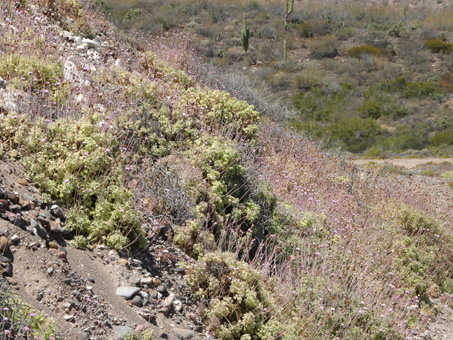
A closer look shows that the Hofmeisteria is blooming profusely. Pink balls on long stalks.
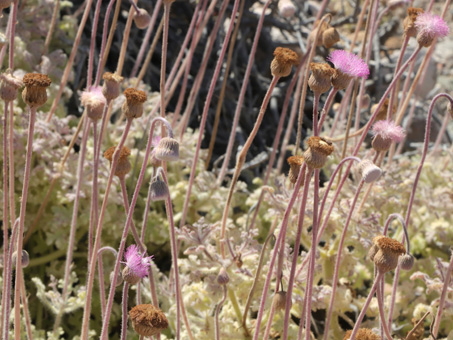
The 1.5-2 cm D pink pompoms of (Hofmeisteria fasciculata var. fasciculata) are inexplicably charming. The dry flowers are cute too.

Coast Hofmeisteria growing in the arroyo on the bluff in the shade. Leaves are thin and broad, with some glandular hairs. Herbage thickens and vestiture gets denser with increasing aridity and exposure to sun.

By comparison, Coast Hofmeisteria growing close to the sea (where salt spray is common) usually have succulent, densely hairy herbage.
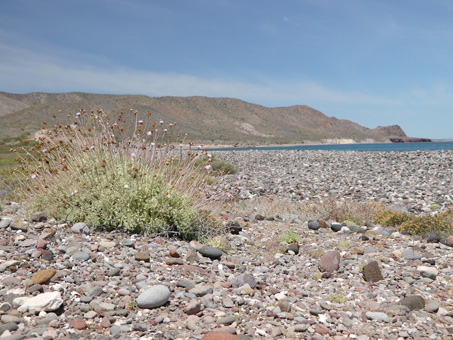
Coast Hofmeisteria does well in sand and in cobbly beach berms.
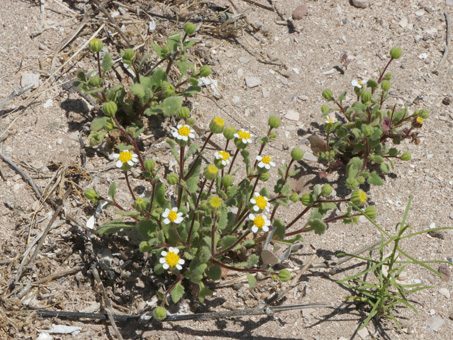
Emory Rock-Daisy (Perityle emoryi, Asteraceae), common here in immediate coastal areas.

A lone Passionflower (Passiflora pentaschista, Passifloraceae) growing in the cobbly beach berm.
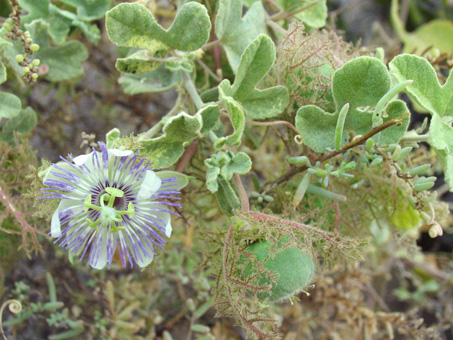
Photo of Passiflora pentaschista flowers, previously taken near a different beach.
Scrub on the Bajada (Alluvial Fan)
Below are photos from the bluff trail, those on the left from April 5, and on the right from today )May 3). During this month, the weather has generally trended up in both temperature and humidity with overnight lows about 5°F higher, and daytime highs about 10°F warmer (now mid to high 80s). The relative humidity is about double, from previously around 20-40% to the current 40-80% throughout any given day.
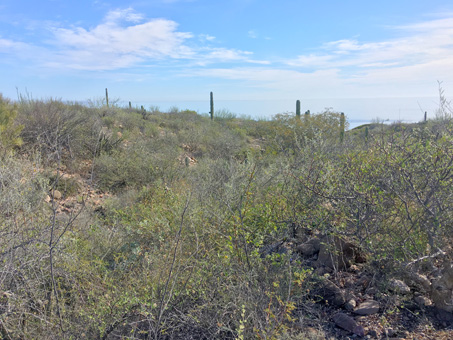
April 5, 2020. The last good rain was in early March.
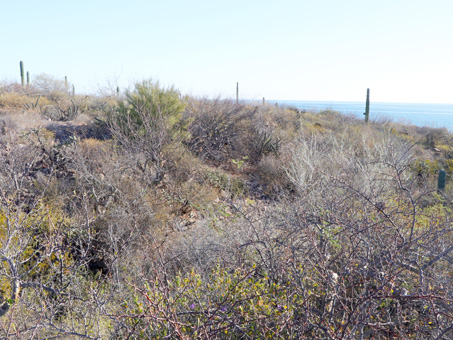
Same location, May 3, 2020.
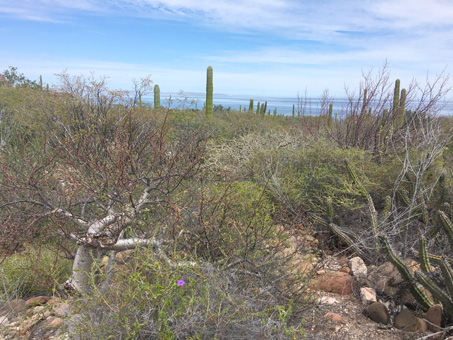
April 5

May 3
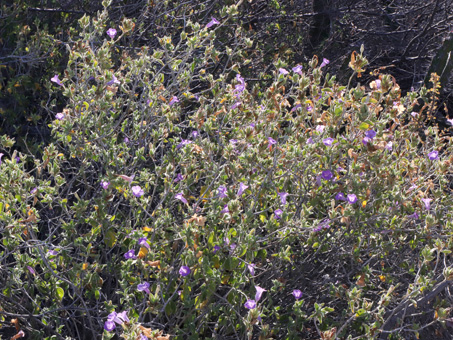
May 5. One of the prinicipal shrubs in bloom was Flor de Campo / Baja California Wild-Petunia (Ruellia california var. californica (Acanthaceae).
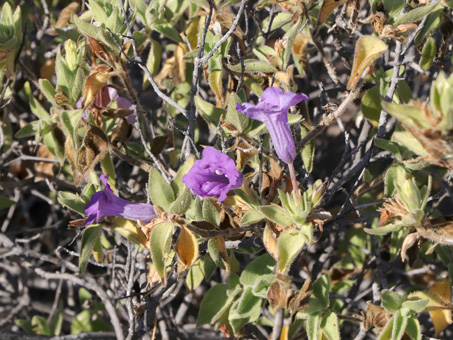
The herbage is glandular and in the heat, the plants can be smelled from a distance (May 5).
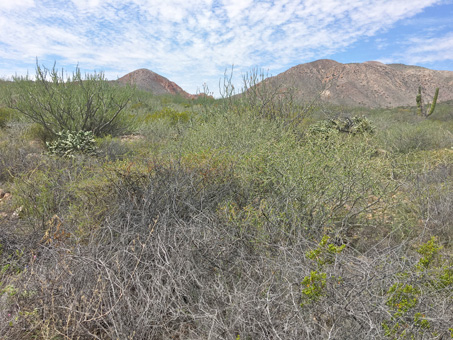
April 5. Not as green as last month, but more so than today.
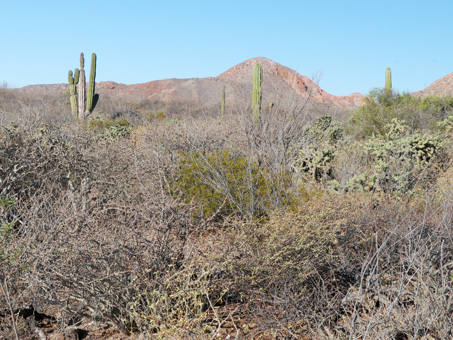
Nearby. Most shrubs & trees are losing their leaves. May 3.
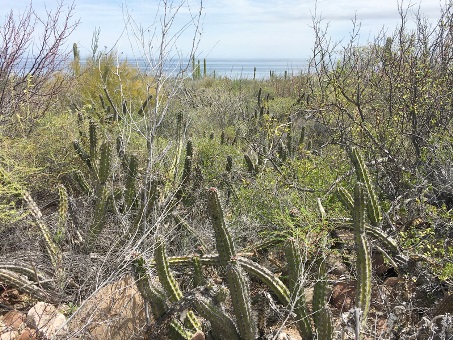
April 5
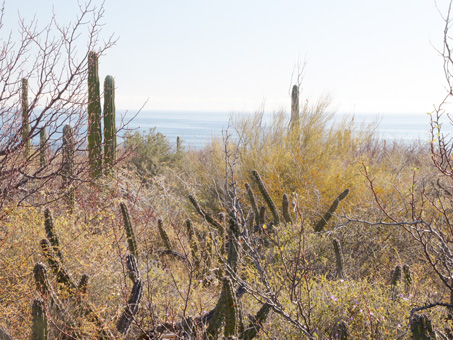
May 3. Euphorbia magdalena, Parkinsonia microphylla, Fouquieria burragei and Bursera spp. add the most color to this desert view.
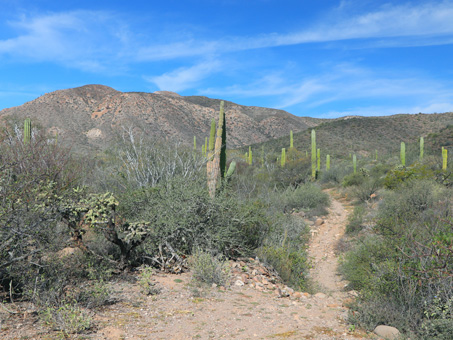
April 5
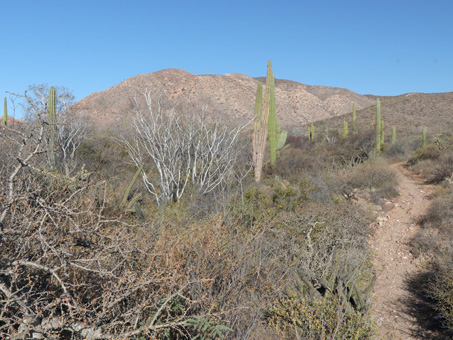
May 3. Many of the annual herbs have gone to seed or are absent.
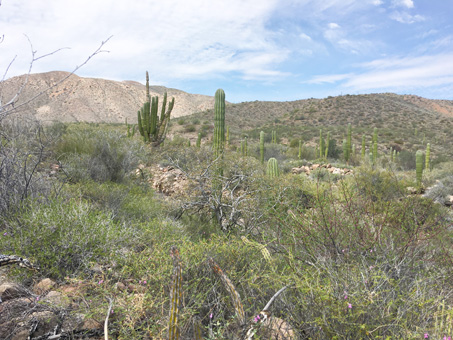
April 5, 2020
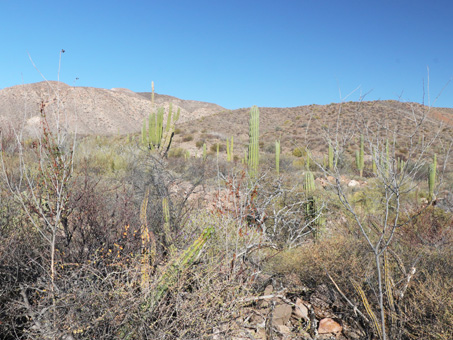
May 3, 2020. Vegetation "thinning out" as vines and annual die back, and shrubs and trees lose their leaves.
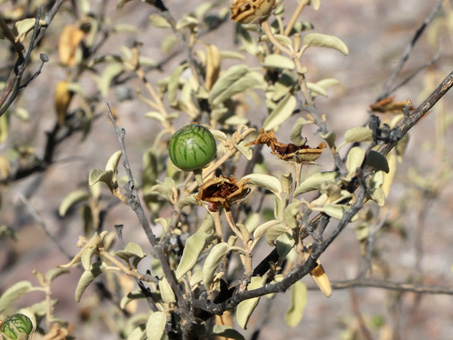
May 3. Baja California Nightshade / Mariola (Solanum hindsianum, Solanceae). Refresh your memory of this same plant as seen last month.
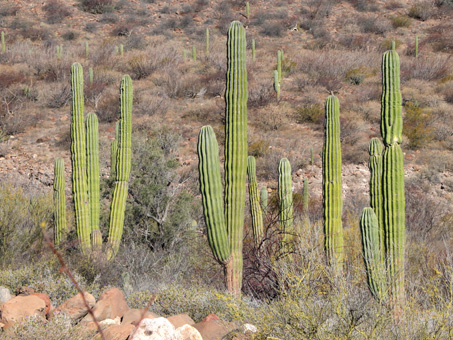
May 3. On this bajada, the majority of Cardons (Pachycereus pringlei) are still not showing signs of flower buds. The second tallest stem on the left was the only sign of buds I saw on the bluff trail. Elsewhere around town and Bahía Concepción flowering is in full swing.
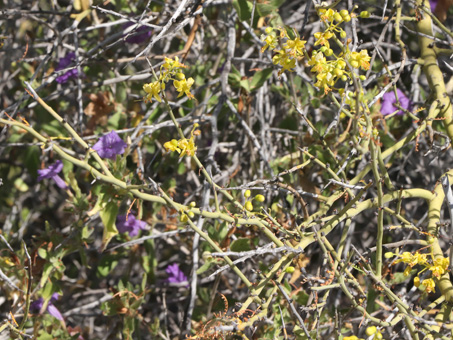
May 3. Baja California Wild-Petunia peeking through the flowering branches of a Little-leaf Palo Verde (Parkinsonia microphylla, Fabaceae). The Palo Verde were just starting to bloom around town. Like the Cardón, they were in full bloom around Bahía Concepción.
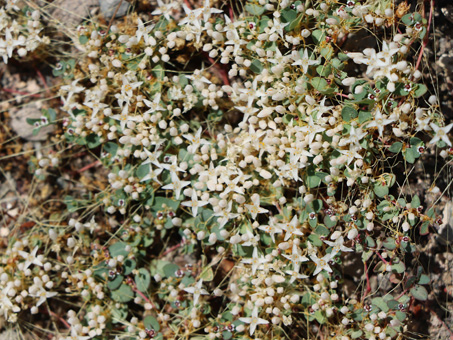
Chupones/Dodder (Cuscuta legitima, Convolvulaceae) parasitizing a Small-seed sandmat (Euphorbia polycarpa var. polycarpa).
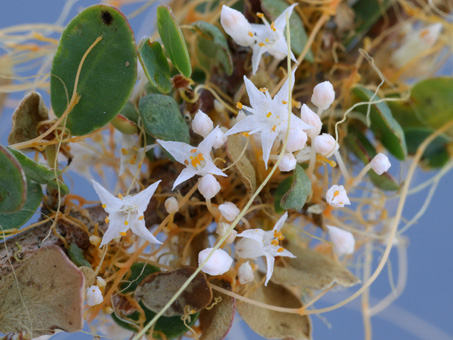
Chupones/Dodder (Cuscuta legitima, Convolvulaceae) parasitizing a Small-seed sandmat (Euphorbia polycarpa var. polycarpa).
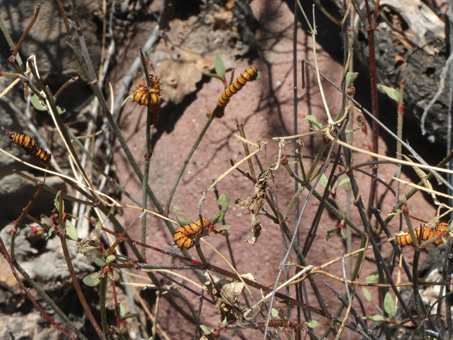
April 3. A hoard of orange and black caterpillars laying waste to the new leaves of Narrowleaf Goldshower (Galphimia angustifolia, Malphigiaceae) that I had first noted in March after the rain.
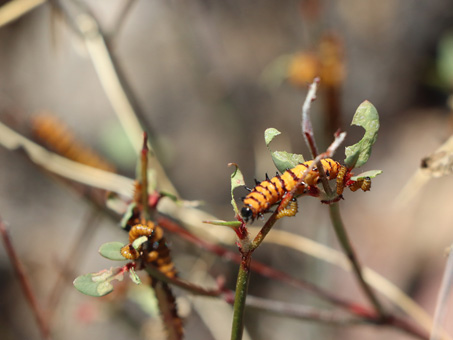
April 3. Closeup of the orange and black caterpillars. On today´s walk (May 3), I had hoped to see flower buds on some of the Galphimia plants, but no luck! Most once again looked "dead" (but dormant).
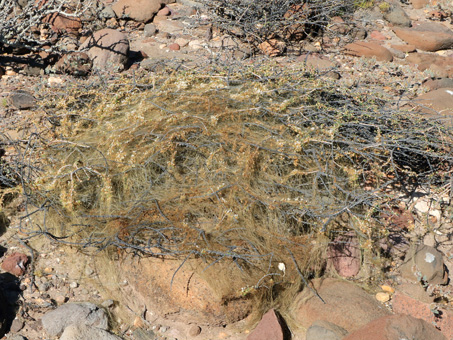
This photo looks distorted, but it's actually a wind-shaped, prostrated Golondrinón (Euphorbia magdalena) engulfed almost entirely by parasitic Dodder/Chupones (Cuscuta legitima).
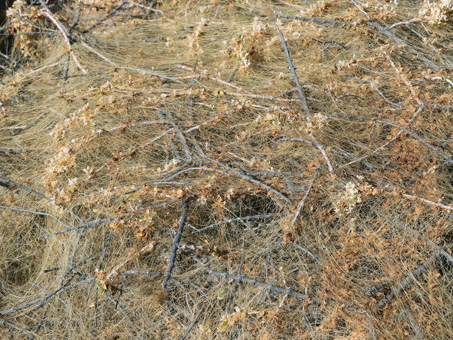
Cuscuta on Golondrinón. The brighter orange patches are the live stems of the parasite, while the dead ones are pale and wispy. The host plant is about 1 m D and about 30-40 cm H.
Species List for the Bajada
Species listed below in bold type were not featured in this month's entry. Links are provided to some of these if there are existing photos on this site.
Shrubs and trees: Aeschynomene nivea, Ayenia compacta (California ayenia), Bebbia juncea var. juncea, Bursera hindsiana, Bursera microphylla, Callaeum micropterum (Hillyhock, Gallineta), Colubrina viridus Cordia parvifolia (Little-leaf Cordia, Vara prieta), Cottsia gracilis (Slender Janusia, Fermina), Desmanthus fruticosus (Baja California Bundleflower; Daí, Frijolillo), Euphorbia magdalena, Fouquieria burragei, Galphimia angustifolia (Narrow-leaf Goldshower), Hibscus denudatus, Hoffmannseggia intricata (Gulf Rush-pea), Horsfordia newberryi, Jacquemontia eastwoodiana, Krameria erecta, K. pauciflora Larrea tridentata (Creosote, Gobernadora), Lycium andersonii var. pubescens (Hairy Desert Thorn), Lysiloma candidum, Marina parryi (Parry marina), Melochia tomentosa (Teabush, Malvarosa), Olneya tesota (Desert Ironwood), Parkinsonia microphyllum (Palo Verde, Dipua), Prosopis articulata (Mesquite), Ruellia californica subsp. california, Simmondsia chinensis, Solanum hindsianum, Tephrosia palmeri (Palmer Hoary-Pea, Frijolillo).
Cacti: Cylindropuntia alcahes var. alcahes, Cylindropuntia cholla, Echinocereus bigelovii, Lophocereus schottii, Mammillaria dioica, Pachycereus pringlei, Stenocereus gummosus
Annual and perennial herbs: Allionia incarnata, Amaranthus watsonii, Cuscuta legitima, Datura discolor, Ditaxis brandegeei var. brandegeei, D. lanceolata, Eriogonum inflatum, Euphorbia pediculifera, E. polycarpa, E. setiloba, Hofmeisteria fasciculata var. fasciculata (Coast Hofmeisteria), Mentzelia adhaerans, Perityle californica, P. emoryi, Phaseolus filiformis, Physalis crassifolia, Porophyllum gracile (Slender Poreleaf, Odora, Hierba del Venado), Pseudorontium cyathiferum, Senna confinis, Sphaeralcea ambigua.
Grasses: Aristida adscensionis (Six-weeks Three-awn, Zacate tres barbas), Bouteloua aristidoides (Needle Grass, Navajitas), Cenchrus ciliaris (Buffelgrass, Zacate bufel), Cenchrus palmeri (Southern Sand-bur, Huizapol).
I hope you´ve enjoyed this month´s entry and it got you "outside" again for a little vicarious botanizing. Until next month, stay safe and hasta pronto...
Debra Valov—Curatorial Volunteer
References
Rebman, J. P., J. Gibson, and K. Rich, 2016. Annotated checklist of the vascular plants of Baja California, Mexico. Proceedings of the San Diego Society of Natural History, No. 45, 15 November 2016. San Diego Natural History Museum, San Diego, CA. Full text available online.
Rebman, J. P and Roberts, N. C. (2012). Baja California Plant Field Guide. San Diego, CA: Sunbelt Publications. Descriptions and distribution.
Wiggins, I. L. (1980). The Flora of Baja California. Stanford University Press. Keys and descriptions.



















